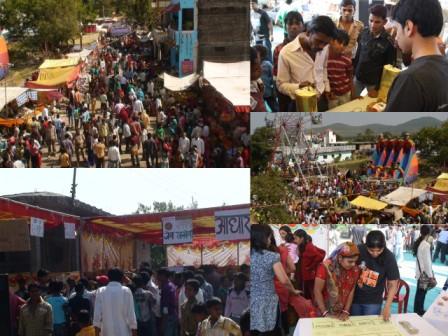UTSAHA 2011, the rural marketing festival of IIM Indore completed its field research with much fun and fervour in the back drop of Karthik Purnima Mela ( 9-10th Nov) at Janapav kutti village, near Indore. Currently in its 4th edition, Utsaha is a student organised annual market research event which aims to understand and analyze rural consumer buying behaviour by undertaking market research projects from SMEs, Corporates, Institutes and Governments. Please find below a report on the festival shared by the Media and Public Relations Committee of IIM Indore and the Utsaha team.

HISTORY
In last 3 years, UTSAHA-rural market research cell at IIM Indore has provided leading FMCG firm insights for their brands and competition. This helps Brand managers assess their positioning and plan for future course of action. It has also assisted MP State Government in assessing the awareness level of projects from ministry of health and education.
UTSAHA has been associated with some of the biggest names in the industry by carrying out market research for HUL, Pidilite, Airtel, Reckitt Benckiser and Cadbury among others.
OUR APPROACH
Like last year, field research this year also was conducted during “Karthik Purnima Mela” at Janapav kuti Village, Indore which attracts more than 50,000 footfalls in 3 days. Typically, village haats and melas bring a diverse mix of rural segments which can be a good sample for marketing research. In order to increase interest levels and attract crowds to participate in the research survey, Events team organizes crowd pulling events and announcements. For the first time magic shows were organized to pull the crowd and it became a huge success.
Project specific responses are taken in disguise of innovative games which try to engage respondents while responses are noted down. This helps in achieving an unbiased market research unlike conventional techniques where sensitization effect hampers questionnaire based research.
While these games are fun and interesting on the outside, in reality they capture the true preferences and behavior of the consumer. Several qualitative techniques are employed in the process. Year after year, the students of IIM Indore, with guidance from eminent faculty and industry experts, have churned out quality market research output in back drop of UTSAHA.
RECENT DEVELOPMENT
This year Utsaha has moved from brand or product specific research to focus on contemporary issues faced by companies that can be useful to organizations intending to build strong rural based market. With research topics like impact of new SEC classification, awareness and demand of nutrition based products, influence of vocational courses/training on rural youth and buying behavior for farm equipments, Utsaha 2011 tried to increase its scope. Another interesting project has been from UIDAI to identify the awareness levels of AADHAAR among rural consumers and understand what aspect of AADHAAR’s benefit strikes a cord with them. Recently, Utsaha has also tied up with MART, a national rural marke research agency as its knowledge partner.
Projects @ Utsaha
(We give you a flavour of 3 projects below out of the many at Utsaha 2011)
Domain: Farm Equipment
Primary objective: To develop a psychographic segmentation of rural men for farm equipments.
Secondary objectives:
- Determine the key attitudinal segments in the market
- Measure Brand awareness levels
- Develop a demographic and geographic profile of the segments.
- Develop interest and opinion parameters
Sample TG: Rural Male, Age group (20-45 years), Occupation – Farming
Planned sample size: 200
Responses Collected: 226
The responses were collected through a series of games as listed below
Tractors – Checking brand awareness, brand recall, attribute preferences and brand perception for tractors
Respondents were asked to tell the brands and attributes based on top of mind recall. Corresponding cards containing brand and attribute image were handed over to them. Then they were asked to rank the attributes on the staircase based on their importance and then place the brand cards corresponding to each attribute.
Response capturing games:
Table Golf – Attribute Preference and Brand Perception for pumps
Respondents were asked to pick balls containing brand names based on top of mind recall. For attributes, respondents had to pass the balls one by one from the gates of different attributes based on their importance and for each attributes they were asked to pass balls containing brand names based on their importance.
Scenarios – Associate Yourself (Based on AIO Model) for cluster analysis
Respondents were shown pictures of two extreme scenarios, based on different parameters like their attitude, interests and opinion. They were asked to rate themselves between those two scenarios based on their perceived association with them.
Path Finder – This game helps in identifying the influencers in the decision making by using pictures and asking the respondents to chart of path of decision making
Domain: Rural Segmentation
Primary Objective: Develop a methodology to determine the Household Income of rural consumer and profile the differences between the old and new rural SEC classification.
Secondary Objectives:
- Identify the sources of income and the contribution from each source
- Identify their key expenditure heads
- Determine the key differences of old and new SEC classification on assets owned, family size, occupation and education level of head of family
Target Group: 20 years and above working adult ( chief earner of the family)
Planned sample size: 200
Responses Collected: 220
The whole project was divided in following three major parts:
Income Determination from Expenses and savings: Exploratory research revealed that the rural consumers would provide inaccurate information if they are asked about their expenses and savings directly. A online horoscope was made in Hindi for the questions related to expenses and savings. Target group was asked to provide accurate answers to the questions posted by the computer and in return the computer would predict their future. The objective of this game was to give the respondent an incentive to be honest with the answers. Computer gave the future based on the horoscope sign of the person and not on the responses received.
Assets Information: Target group was shown pictures of common assets such as TV, fan, furniture etc and were asked to identify the assets owned by their family.
Identifying the sources of Income: At this stage the respondents were asked to list down all the sources which generate income for their family. Some pictorial charts were used to aid the respondents so that they do not miss out on any income source.
Domain: Nutrition
Primary Objective: To understand the perception of rural female towards nutritional supplement food.
Secondary Objectives:
- Identify the ways in which rural young women maintain the health (nutrition) of their family and themselves
- Determine the awareness of the nutrition supplements among rural young women
- Determine the key parameter to evaluate a nutritional supplement.
- Determine the willingness to purchase a nutritional supplement and the price willing to pay
Sample TG: Rural women, Age Group (15-28 yr)
Planned sample size: 200
Responses Collected: 250
The stall was decorated with posters of movie stars and was called ‘suno sakhi’ to attract female crowd and to appear friendly. Questions were asked through gamed pictorial representations and games in order to keep the respondent interested and to aid comprehension.
One of the first games was to assist in understanding buying behavior. It required the respondent to pick out the typically used cooking items like oil, pulses, milk from a number of available options and put them in a plate. This helped in understanding the popularity of these items like biscuits and packages drinks.
One of the main games required the respondents to pick out meaningful nutritional words like vitamins and proteins from a number of options. They were told that 5 out of the given 9 were correct and required arranging them in the shape of a flower. Since the TG was primarily female, special care was taken to design more feminine game structure as opposed to typical ballthrowing games.
The most complex question for understanding buying behavior was to ask the importance of parameters like price, proper packaging and ingredients on a 5 point likert scale. It also scored benefits like physical development and memory. The game asked them to pick a box from the 5 sizes available for every parameter. A larger box would indicate more importance. This design ensured that even illiterate respondents were able to answer

